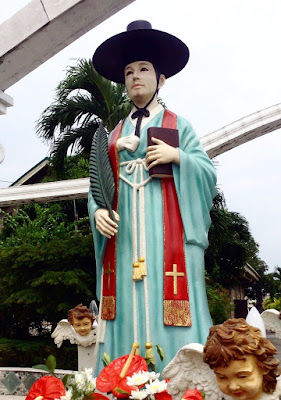St. Andrew Kim Taegon - Our Holy "Oppa" in the Philippines
 |
| St. Andrew Kim Taegon of Lolomboy, Bulacan |
With the current fascination of Filipinos to anything related to Korean Culture, let us have a look one of the most illustrious Koreans in history that most Filipinos failed to realized, or never heard of before.
His Early Life
Saint Andrew Kim Taegon was born in August 21, 1821 in Nol-Mae (Solmoe), Chu’ung-Chong Province (in South Central Korea. At the age of seven, the Kim family moved to Golbaemasil Mankok-ri, Youngin-gun County (Mirinae) Kyungki Province. Kim’s great-grandfather, Kim Jin-Hu was martyred in 1814. Kim’s grand-uncle, Kim Han-hyun was also martyred in 1816. Kim’s father, Kim Je-jun (Ignatius Kim), was subsequently martyred in 1839 for practicing Christianity. With so many male relatives martyred, Kim grew up very poor; his mother reduced to begging.
 |
| Korean Priests teaching the Korean faithful |
 |
| The persecution of Korean Catholics |
At this time, Korea was isolated from the world; the only outside contact being with Peking, where taxes were paid. Jesuits in China managed to smuggle Christian literature into Korea. In 1836, Korea saw its first consecrated missionaries arrived, only to find out that the people there were already practicing Korean Catholics and Koreans were already practicing Christianity.
 |
| St. Andre Kim Taegon in his priestly vestment |
After being baptized at age 15, Kim studied at a seminary in the Portuguese colony of Macau. He was ordained a priest in Shanghai after nine years in 1844 by the French bishop Jean-Joseph-Jean-Baptiste Ferréol.
A Fateful Visit in Lolomboy
According to research by writers, during the time when Christians were persecuted and persecuted in Korea. At the age of 16, he was a seminarian at that time when he went to Macau as a scholar of the Paris Foreign Mission Society. The civil war in China between 1837 - 1839 erupted that forced him to seek refuge and study in a Dominican convent located in Lolomboy, Bulacan. His knowledge in French made him an interpreter of Admiral Cecile of the French Army, an ally of Spain, went to Manila in 1842. He lived in Lolomboy in 1837, 1839, and 1841.
 |
| St. Andrew Kim Taegon |
He then returned to Korea to preach and evangelize. During the Joseon Dynasty, Christianity was suppressed and many Christians were persecuted and executed. Catholics had to covertly practice their faith. Kim was one of several thousand Christians who were executed during this time. In 1846, at the age of 25, he was tortured and beheaded near Seoul on the Han River. His last words were:
"This is my last hour of life, listen to me attentively: if I have held communication with foreigners, it has been for my religion and for my God. It is for Him that I die. My immortal life is on the point of beginning. Become Christians if you wish to be happy after death, because God has eternal chastisements in store for those who have refused to know Him."
Before Ferréol, the first bishop of Korea, he died from exhaustion on February 3, 1853, he wanted to be buried beside Kim, stating, “You will never know how sad I was to lose this young native priest. I have loved him as a father loved his son; it is a consolation for me to think of his eternal happiness.”
On May 6, 1984, Pope John Paul II canonized Kim along with 102 other Korean Martyrs, including Paul Chong Hasang, during his trip to Korea. Their memorial is commemorated every September 20.
 |
| The Shrine of St. St. Andrew Kim Taegon in Lolomboy, Bocaue, Bulacan |
The Parish of Sto. Cristo and Saint Andrew Kim was established in 1959. The parish was declared a sister parish of a shrine also dedicated to Kim-Taegon in South Korea in 1986. Seoul Archbishop Stephen Cardinal Kim gave a statue of St. Andrew Kim-Taegon to the parish which was then enshrined on the old church building.
The construction of the New church building began in 2001 under the watch of then parish priest, Rev. Fr. Avel Sampana. The construction coincided with the 50th anniversary of the parish. The Shrine at present was under the custodianship of the Parish and the Sisters of St. Andrew, a congregation of Korean nuns.
A feature of the Shrine is located in the main chapel where the wood that was used to make the altar was from the actual tree were it is said that St. Andrew Kim used to stay and hugged, whenever he is homesick and missing his family. Another feature was the actual spot where he used to stay that can still be visited by pilgrims.
As we discover this short yet meaningful chapter in our Church history, let us keep in mind the suffering of our brethren who are still under persecution for various reasons and needed our prayers and support to keep the faith alive. As we honor their sacrifice. They help us to remember that faith is a virtue that makes it possible to know and believe in God. Their sacrifice also reminds us that we are blessed to live in a country where we are free to live our faith.
St. Andrew Kim Taegon, Pray for us!
References:
Michael Walsh, ed. (1991) "Butler's Lives of the Saints", Harper Collins Publishers: New York.
The Fathers of the London Oratory, tr., (1859), The New Glories of the Catholic Church, p.118, Richardson and Son, London.
"The Lives of the 103 Korean Martyr Saints: St. Kim Tae-gon Andrew," Catholic Bishops' Conference of Korea Newsletter No. 27 (1999).
Walker, Timothy (2015). "Historic Church Built in Honor of 18th Century Korean Saint in Bocaue, Bulacan". Philippine Lifestyle News. Retrieved December 3, 2017.





Comments
Post a Comment